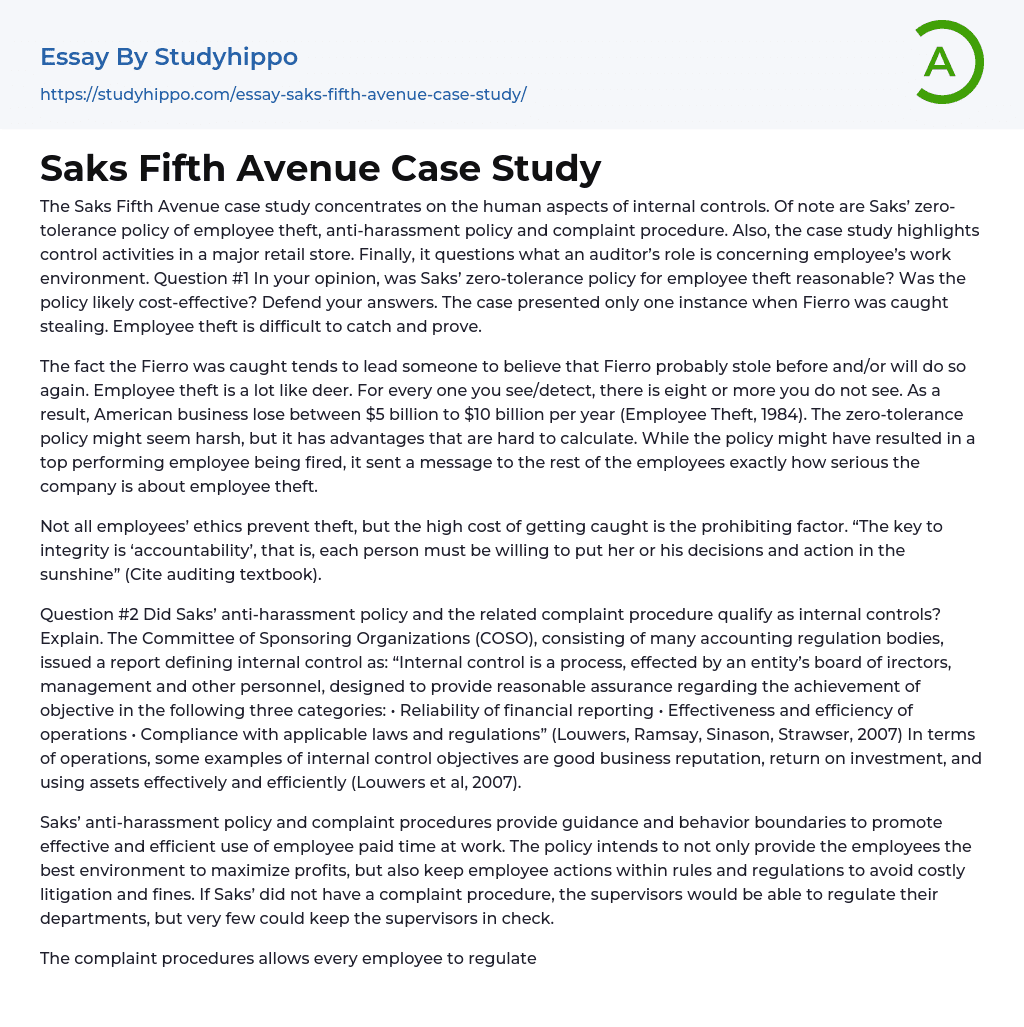The Saks Fifth Avenue case study concentrates on the human aspects of internal controls. Of note are Saks’ zero-tolerance policy of employee theft, anti-harassment policy and complaint procedure. Also, the case study highlights control activities in a major retail store. Finally, it questions what an auditor’s role is concerning employee’s work environment. Question #1 In your opinion, was Saks’ zero-tolerance policy for employee theft reasonable? Was the policy likely cost-effective? Defend your answers. The case presented only one instance when Fierro was caught stealing. Employee theft is difficult to catch and prove.
The fact the Fierro was caught tends to lead someone to believe that Fierro probably stole before and/or will do so again. Employee theft is a lot like deer. For every one you see/detect, there is eight or more you do not see. As a
...result, American business lose between $5 billion to $10 billion per year (Employee Theft, 1984). The zero-tolerance policy might seem harsh, but it has advantages that are hard to calculate. While the policy might have resulted in a top performing employee being fired, it sent a message to the rest of the employees exactly how serious the company is about employee theft.
Not all employees’ ethics prevent theft, but the high cost of getting caught is the prohibiting factor. “The key to integrity is ‘accountability’, that is, each person must be willing to put her or his decisions and action in the sunshine” (Cite auditing textbook).
Question #2 Did Saks’ anti-harassment policy and the related complaint procedure qualify as internal controls? Explain. The Committee of Sponsoring Organizations (COSO), consisting of many accounting regulatio
bodies, issued a report defining internal control as: “Internal control is a process, effected by an entity’s board of irectors, management and other personnel, designed to provide reasonable assurance regarding the achievement of objective in the following three categories: • Reliability of financial reporting • Effectiveness and efficiency of operations • Compliance with applicable laws and regulations” (Louwers, Ramsay, Sinason, Strawser, 2007) In terms of operations, some examples of internal control objectives are good business reputation, return on investment, and using assets effectively and efficiently (Louwers et al, 2007).
Saks’ anti-harassment policy and complaint procedures provide guidance and behavior boundaries to promote effective and efficient use of employee paid time at work. The policy intends to not only provide the employees the best environment to maximize profits, but also keep employee actions within rules and regulations to avoid costly litigation and fines. If Saks’ did not have a complaint procedure, the supervisors would be able to regulate their departments, but very few could keep the supervisors in check.
The complaint procedures allows every employee to regulate each other, resulting in conformity by all to the policy. Question #3 Identify five control activities that you would commonly find in a men’s clothing department of a major department store. Identify the control objective associated with each of these activities. Computer based cash registers: Such systems automatically record various types of relevant data. Examples include employee codes, items and quantity purchased, totals due, type of payment, etc.
This is a form of segregation of duties, which increases the difficulty to input fraudulent data, since the limited user interface allowed to the employee Limited authorization to
edit sales: Occasionally, departure from normal sales procedure occur, like returns, change in sale prices, and corrections for improper entries. Limited authorization powers are entrusted to key personnel, and can include a two person concept to document such departures.
This is also another segregation of duties Third party counting of ash: At the end of a shift, the employee turns in his or her change drawer to another department for counting. That department has the list of transactions associated with that cash drawer, and compares the cash, checks, coupons, and credit card receipts to the list of transactions listed. Any deviations can alert management to either incorrect entry procedures, or employee theft. This is also a segregation of duties. Notice a theme? Inventory: Periodic inventory of goods allows comparison of physical goods to what records say there should be on the shelves.
It is better to have an independent person, whether a private company or someone from another department. However, use of same department’s personnel is acceptable as long as the personnel rotate inventorying different sections. The independent inventory provides a segregation of duties. Video surveillance: Video surveillance can provide both detection and preventative measures to prevent both shoplifting and employee theft. The objective is to catch the crime in progress, provide evidence, and provide incentive not to steal.
- Audit essays
- Budgeting essays
- Cost Accounting essays
- American Dream essays
- Barriers To Entry essays
- Capitalism essays
- Central Bank essays
- Compensation essays
- Consumerism essays
- Economic Development essays
- Economic Growth essays
- Economic Inequality essays
- Economic System essays
- Economy essays
- Employment essays
- Export essays
- Finance essays
- Free Trade essays
- Gross Domestic Product essays
- Human Development essays
- Income Inequality essays
- Industry essays
- Inflation essays
- International Business essays
- International Trade essays
- Macroeconomics essays
- Materialism essays
- Max Weber essays
- Microeconomics essays
- Minimum Wage essays
- Monetary Policy essays
- Monopoly essays
- Pricing essays
- Profit essays
- Recession essays
- resources essays
- Taxation essays
- Trade essays
- Unemployment essays
- Warehouse essays
- World economy essays
- Accountability essays
- Accounting Software essays
- Accounts Receivable essays
- Auditor's Report essays
- Balance Sheet essays
- Cash essays
- Cash Flow essays
- Costs essays
- Financial Audit essays




